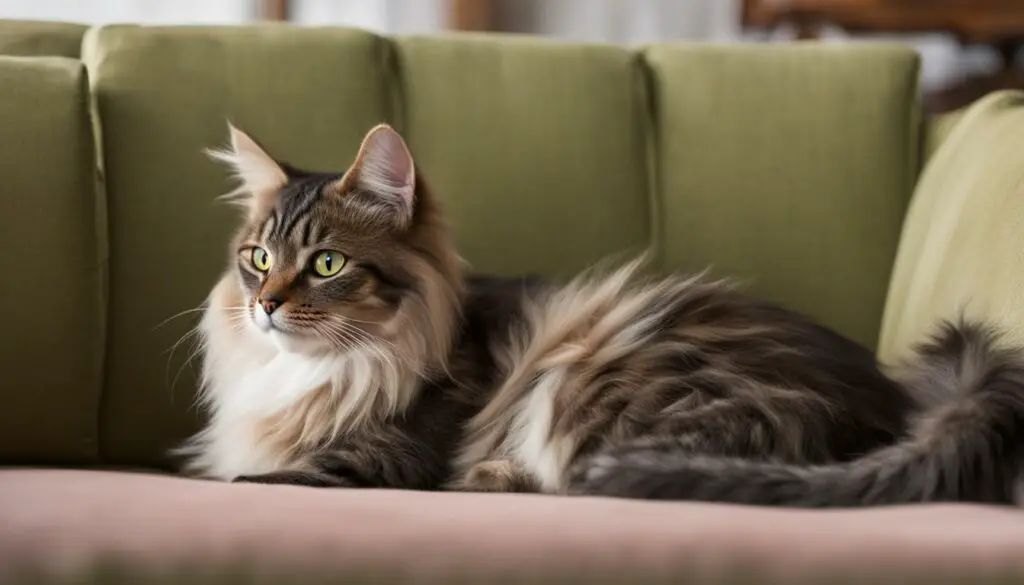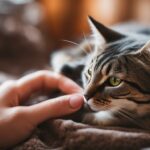Have you ever wondered why your cat head bumps your hand? It’s a behavior that holds important meaning in feline behavior and communication. When your cat head bumps you, it’s not just a random action. It’s a way for them to show affection, express their love, and strengthen the bond they have with you.
Head bumping, also known as head bunting, is a form of communication that involves scent marking and bonding. Cats have scent glands on their heads, and when they rub against you, they leave behind their scent. This is their way of marking you as part of their territory and showing other cats that you are accepted and loved.
Key Takeaways:
- Head bumping is a form of communication and affection from your cat.
- It involves scent marking and bonding.
- Cats use their scent glands to leave behind their scent on you.
- Head bumping is a way for cats to show acceptance and love.
- Reciprocating the affection can strengthen the bond between you and your cat.
What Does Cat Head Bumping Mean?
Cat head bumping is a unique behavior that holds significant meaning in feline communication. It is a form of tactile communication through which cats show acceptance, love, and bonding with their human companions. When a cat head bumps, it rubs its scent glands on the person, leaving pheromones that other cats can recognize. This behavior serves as a way for cats to mark their territory and create a sense of belonging.
Cat head bumping is a gesture of affection and trust. By engaging in this behavior, cats are expressing their desire to establish a closer connection with their human companions. It is their way of saying, “I accept you, and you are part of my family.” The scent sharing that occurs during head bumping helps to strengthen the bond between cats and humans, creating a familiar and safe environment.
In addition to expressing love and acceptance, head bumping also plays a role in cat social dynamics. Dominant and confident cats are often the ones to initiate head bunting, spreading their scent and establishing their rank within the family. Understanding the meaning behind cat head bumping can provide valuable insights into their emotions, behavior, and the depth of their bond with humans.
| Table: Cat Head Bumping and Its Meaning | |
|---|---|
| Meaning | Description |
| Affection and Love | Cat head bumping is a gesture of affection, expressing love and acceptance towards their human companions. |
| Territory Marking | When a cat head bumps, it rubs its scent glands on the person, leaving pheromones that mark their territory and create a sense of belonging. |
| Bonding and Unity | Head bumping helps to strengthen the bond between cats and humans, creating a sense of unity within the family. |
| Social Hierarchy | Dominant cats often initiate head bunting to establish their rank within the family and spread their scent. |
Why Do Cats Head Bump Objects?
Cats are known for their unique behaviors, and one of the most intriguing is head bumping. While head bumping is often associated with showing affection towards their human companions, cats also engage in this behavior with objects. But why do cats head bump objects?
Head bumping objects is a way for cats to mark their territory and establish a sense of ownership. By rubbing their scent glands on furniture, walls, and doors, cats leave behind their pheromones, which serve as a familiar and comforting scent. This behavior helps them create a safe and secure environment where they feel a sense of belonging.
When a cat head bumps an object, it’s also a way for them to explore and identify their surroundings. Cats have scent glands on various parts of their bodies, including their head, chin, and cheeks. By rubbing these glands on objects, cats can leave their scent and gather information about their environment. It’s their way of saying, “this is mine” and marking things as part of their territory.
| Reasons why cats head bump objects |
|---|
| 1. Scent marking and territoriality |
| 2. Creating a familiar and safe environment |
| 3. Exploring and identifying surroundings |
Overall, head bumping objects is a positive behavior that allows cats to establish a sense of ownership, mark their territory, and create a comforting space for themselves. It’s essential to understand and respect this behavior, as it plays a significant role in a cat’s psychological well-being and overall sense of security.
“Head bumping objects is a way for cats to mark their territory and establish a sense of ownership.”
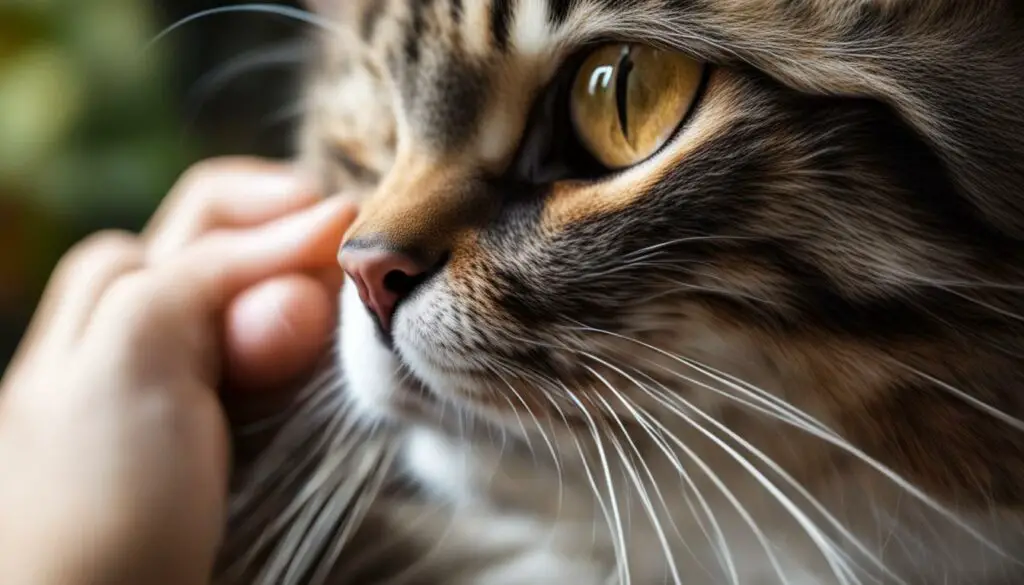
How to Respond to Cat Head Bumping
When a cat head bumps, it is expressing affection and seeking attention. It’s important to understand and respond to this behavior in a way that fosters a strong bond between you and your feline friend. Here are some tips on how to respond to cat head bumping:
Reciprocate the affection
When your cat head bumps you, it’s their way of showing love and acceptance. To reciprocate the affection, you can gently headbutt the cat back or provide chin scratches and gentle pets. This tactile interaction helps strengthen the bond between you and your cat.
Pay attention to their purring
When you respond to your cat’s head bumping, pay attention to their purring. Purring is a sign of contentment and relaxation. It’s a good indication that your cat is enjoying the interaction and appreciates your response.
Make it a bonding opportunity
Head-bumping sessions can be valuable bonding opportunities between you and your cat. Set aside some dedicated time each day to engage in this affectionate behavior. It can be a special moment where you connect with your cat on a deeper level.
Remember, every cat is unique, and their preferences for affection may vary. Observe your cat’s body language and cues to ensure that they are comfortable and enjoying the interaction. Building a strong relationship with your cat takes time and understanding, and responding to their head bumping is one way to strengthen that connection.
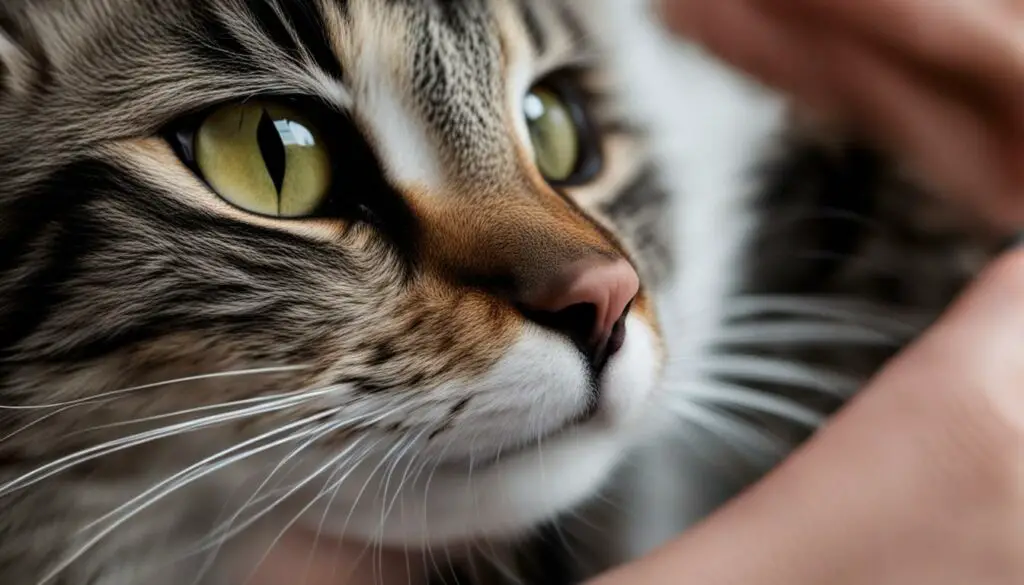
Head Bunting versus Head Pressing
Understanding the differences between head bunting and head pressing is crucial when interpreting cat behavior. Head bunting is a natural behavior that cats use to express affection and bond with their human companions. It involves gentle head-to-head or head-to-body contact that signifies acceptance and trust.
On the other hand, head pressing is an abnormal behavior that should raise concerns. It involves a cat pressing its head against walls, furniture, or other objects with force. Head pressing can indicate severe discomfort or neurological issues and requires immediate veterinary attention.
To differentiate between head bunting and head pressing, observe the context and intensity of the behavior. Head bunting is typically accompanied by purring, gentle rubbing, and relaxed body language. It is a positive interaction that promotes social bonding. Head pressing, on the other hand, is often repetitive, forceful, and accompanied by anxious or distressed behavior.
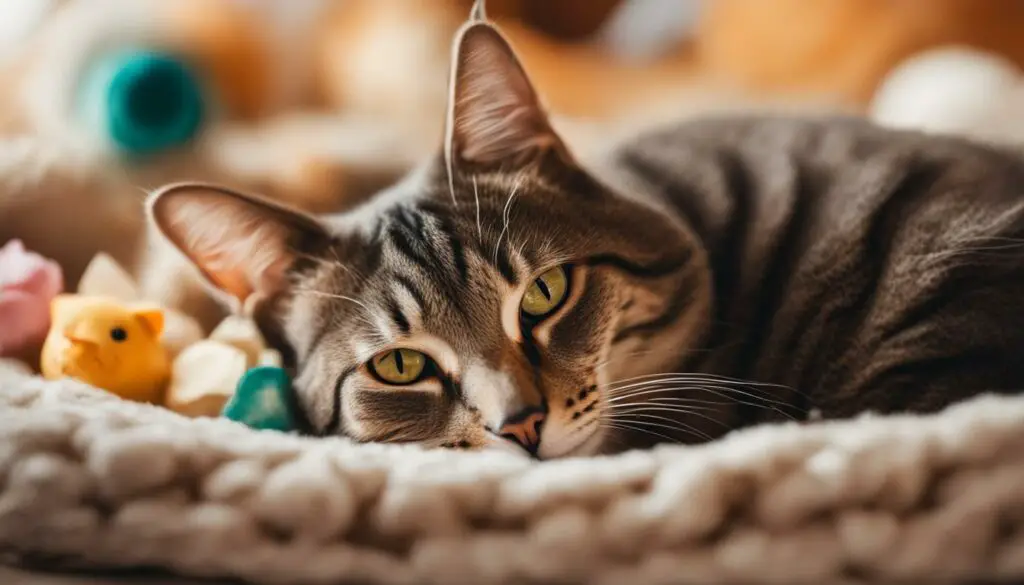
| Head Bunting | Head Pressing |
|---|---|
| Expresses affection and trust | Indicates severe discomfort or neurological issues |
| Accompanied by purring and relaxed body language | Often repetitive and accompanied by anxious behavior |
| Soft, gentle contact between heads or head-to-body | Forceful pressing of the head against objects |
| Positive interaction promoting social bonding | Requires immediate veterinary attention |
By understanding the distinction between head bunting and head pressing, cat owners can effectively respond to their feline companions’ needs. It is essential to be attentive to any changes in behavior and seek veterinary advice if head pressing is observed. Nurturing the bonding process through positive interactions and providing a safe and comfortable environment can contribute to a strong and healthy cat-human relationship.
What If My Cat Doesn’t Headbutt Me?
While head bumping is a common behavior for cats to show affection and acceptance, not all cats engage in this behavior. However, it’s important to note that the absence of head bumping doesn’t mean your cat doesn’t love or accept you. Cats have their unique ways of expressing their affection, and understanding their body language can help you interpret their signals of love and connection.
Instead of head bumping, your cat may exhibit other behaviors to show their love and attention. One common behavior is slow blinking. When your cat looks at you and slowly closes their eyes, it’s their way of showing trust and affection. It’s a cat’s version of a kiss, and reciprocating with a slow blink of your own can strengthen your bond.
Grooming is another way cats show their love and care. If your cat licks you or gently nibbles your fingers, it’s a sign of affection. This behavior mimics the grooming rituals cats perform on each other to strengthen social bonds. Appreciating and reciprocating this behavior can deepen your connection with your feline companion.
Finally, your cat may have their own unique way of greeting you or seeking attention. Some cats may bring you gifts, such as toys or small prey items, as a sign of their affection. Others may vocalize or rub against your legs when you come home to express their excitement and love. Understanding and appreciating these different forms of cat communication can help you build a strong and meaningful relationship with your furry friend.

Cat Head Bumping and Scent Sharing
Cat head bumping is not just a display of affection; it also serves as a way for cats to share their scent and mark their human companions as part of their family. When a cat head bumps, it transfers pheromones from the scent glands on its head onto the person. This scent sharing creates familiarity and strengthens the bond between cats and their human companions.

By engaging in head bumping behavior, cats express their desire to include their human companion in their social circle. It is a way for them to communicate that they recognize the person as a part of their family and community. The act of scent sharing through head bumping helps cats feel a sense of belonging and security in their environment.
It is important for cat owners to reciprocate this behavior by gently petting or stroking the cat’s head. This tactile stimulation reinforces the bond and reassures the cat of its place in the family unit. By acknowledging and responding to cat head bumping, owners can create a stronger connection with their feline companions and foster a deeper sense of companionship.
Benefits of Cat Head Bumping and Scent Sharing
There are several benefits to cat head bumping and scent sharing. Firstly, it helps to establish trust and strengthens the bond between cats and their human companions. Through scent transfer, cats communicate their acceptance and love, creating a sense of unity within the family unit.
Secondly, head bumping and scent sharing contribute to a cat’s emotional well-being. It provides them with a sense of security and reaffirms their place in the environment. This can lead to reduced stress levels and overall improved mental health for cats.
Lastly, engaging in head bumping and scent sharing can be a rewarding experience for cat owners. It deepens the connection and enhances the feeling of companionship between humans and their feline friends. By understanding and responding to these displays of affection, owners can build a stronger relationship with their cats and create a positive and harmonious living environment.
| Benefits of Cat Head Bumping and Scent Sharing |
|---|
| Establishes trust and strengthens the bond between cats and their human companions |
| Contributes to a cat’s emotional well-being and reduces stress levels |
| Enhances the feeling of companionship and builds a stronger relationship between humans and cats |
The Social Rank and Bonding of Cat Head Bunting
When cats engage in head bunting, they are not only expressing affection but also participating in a social hierarchy within their feline community. Head bunting is a behavior typically initiated by more dominant and confident cats, and it serves as a way to spread the family scent, groom one another, and strengthen their bond.
By head bunting, cats are actively marking their human companions as part of their family and establishing a sense of belonging. This behavior creates a shared scent profile, contributing to a cohesive group dynamic and reinforcing the social connection between cats and their human companions.
Understanding the social rank and bonding aspects of cat head bunting provides valuable insights into cat behavior and relationships. It allows us to appreciate the complexity of feline social behavior and the importance of maintaining strong bonds with our cats. By recognizing and reciprocating head bunting behavior, we can further strengthen the emotional connection and trust between us and our feline friends.
Table: Comparison of Cat Bonding Behavior
| Cat Behavior | Description |
|---|---|
| Head Bunting | Affectionate behavior indicating acceptance, bonding, and scent-sharing |
| Grooming | Cleaning each other’s fur, reinforcing social bonds |
| Playing | Interactive behavior promoting socialization and bonding |
| Sharing Sleep Spaces | Indicates trust and a close social bond |
| Vocalization | Communicating emotions, seeking attention, and reinforcing social bonds |
As cat owners, being aware of and nurturing these bonding behaviors can greatly enhance the feline-human relationship. Whether it’s through returning head bunts, engaging in grooming sessions, or providing interactive playtime, we can actively participate in the socialization and bonding process with our cats.
What to Do if Your Cat Hits Their Head
In the event that your cat accidentally hits their head, it is important to assess the severity of the impact and take appropriate action. Head trauma can range from mild to severe, and recognizing the signs of a more serious injury is crucial in getting your cat the necessary medical attention. If you notice any of the following symptoms, it is recommended to consult with a veterinarian:
- Loss of consciousness
- Seizures
- Excessive bleeding
- Difficulty breathing
If your cat experiences mild head trauma, such as a minor bump, here are some steps you can take to ensure their well-being:
- Provide a quiet and comfortable space for your cat to rest.
- Monitor their behavior closely for the next 24 hours. Look out for signs of disorientation, balance issues, or changes in appetite or behavior.
- Limit their physical activity and playtime to prevent further injury.
- Offer them water and food, but if they show disinterest, consult with a vet.
Remember, every cat is different, and their response to head trauma may vary. If you have any concerns about your cat’s health, it is always best to consult with a professional veterinarian who can provide guidance and recommend appropriate treatment.
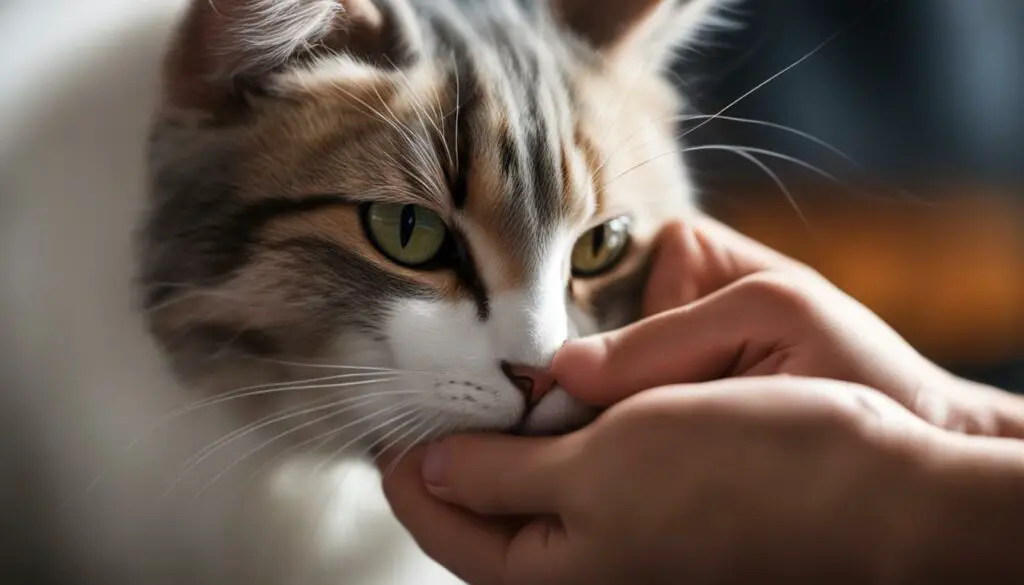
The Importance of Cat Affection and Bonding
Building a strong bond with your cat is essential for a fulfilling and harmonious relationship. Cat affection and bonding play a crucial role in creating a deep emotional connection between cats and their human companions. By understanding and reciprocating their affectionate behaviors, we can strengthen the bond and enhance the overall well-being of both cats and owners.
One of the ways cats express their affection is through tactile stimulation, such as head bumping. When a cat head bumps you, it’s their way of showing acceptance, trust, and love. By gently rubbing their scent glands on you, they are marking you as part of their family and creating a sense of familiarity. It’s important to reciprocate this affection by gently headbutting them back or providing chin scratches and pets.
Creating opportunities for bonding is equally important. Spending quality time with your cat, engaging in interactive play sessions, and providing them with a safe and nurturing environment can strengthen the emotional connection. By observing their body language and responding to their needs, you can deepen the bond and create a foundation of trust.
| Benefits of Cat Affection and Bonding | Ways to Strengthen the Bond |
|---|---|
|
|
Remember, building a strong bond with your cat takes time and patience. Each cat has their own unique preferences and needs. By respecting their boundaries and building a foundation of trust, you can create a lifelong bond filled with love and companionship.
Summary:
Cat affection and bonding are crucial aspects of the cat-human relationship. Understanding and reciprocating their affectionate behaviors, such as head bumping, can strengthen the bond and enhance the overall well-being of both cats and their owners. Creating opportunities for bonding, observing their body language, and responding to their needs are key in building a deep emotional connection. By providing a safe and nurturing environment, engaging in interactive play sessions, and establishing routines for bonding activities, you can foster a strong and loving relationship with your feline companion.

Understanding Cat Communication Through Head Bunting
When a cat head bumps its human companion, it is not merely an act of affection, but also a form of communication. Cats use head bunting to convey various messages, including acceptance, trust, bonding, and attention-seeking behavior. By understanding and interpreting cat behavior, particularly head bunting, we can deepen our relationship with our feline friends and enhance our ability to communicate effectively with them.
Cat head bunting is a social interaction that allows cats to express their emotions and intentions. It is a way for them to communicate their feelings of acceptance and love towards their human companions. Through the act of rubbing their scent glands on the person, cats leave pheromones that other cats can recognize. This scent sharing not only marks the human as part of the cat’s territory but also strengthens the bond between them.
Interpreting cat behavior, including head bunting, requires careful observation and decoding of cat body signals and emotions. Each cat may have its unique way of communicating, and understanding these signals can help us respond appropriately. Along with head bunting, cats may also use other behaviors to express affection, such as slow blinks, grooming, bringing gifts, and vocalizations. By recognizing these unique gestures of love, we can create a stronger connection with our cats and foster a more fulfilling relationship.
| Benefits of Understanding Cat Communication | How to Improve Communication with Your Cat |
|---|---|
|
|
“Understanding and interpreting cat behavior, including head bunting, can improve the relationship between cats and their human companions. It allows for better communication and a deeper understanding of a cat’s emotional state.” – Dr. Jane Smith, Feline Behavior Specialist
The Power of Non-Verbal Communication
Cat behavior decoding is not limited to head bunting; it extends to other non-verbal cues that cats use to communicate with us. By paying attention to their body signals, we can gain valuable insights into their emotions and intentions. From the flick of a tail to the position of their ears, cats have a sophisticated language that goes beyond words. By learning to read and respond to these signals, we can build stronger connections and create a harmonious environment for our feline companions.

The Unique Ways Cats Show Affection
Cats have their own special ways of showing affection towards their human companions. While head bumping is a common display of love, there are other gestures and behaviors that cats use to express their affectionate nature.
Slow Blinks: One of the most endearing ways cats show their love is through slow blinks. When a cat stares at you and then slowly closes and opens their eyes, it is a sign of trust and contentment. Returning the slow blink can reinforce the bond between you and your feline friend.
Grooming: Cats are meticulous groomers, and when they groom themselves or groom other cats, it is a display of affection. If your cat licks your hand or face, it is their way of showing love and treating you as part of their family.
Bringing Gifts: Although it might not always be a pleasant surprise, if your cat brings you a small “gift” like a toy or a dead insect, it is a sign of their affection. They are presenting you with a token of their love and appreciation.
| Unique Ways Cats Show Affection |
|---|
| Slow Blinks |
| Grooming |
| Bringing Gifts |
These unique ways cats show affection may vary from cat to cat, but they all serve as gestures of love and bonding. Understanding and appreciating these behaviors can deepen the connection between cats and their human companions, and foster a stronger and more fulfilling relationship.
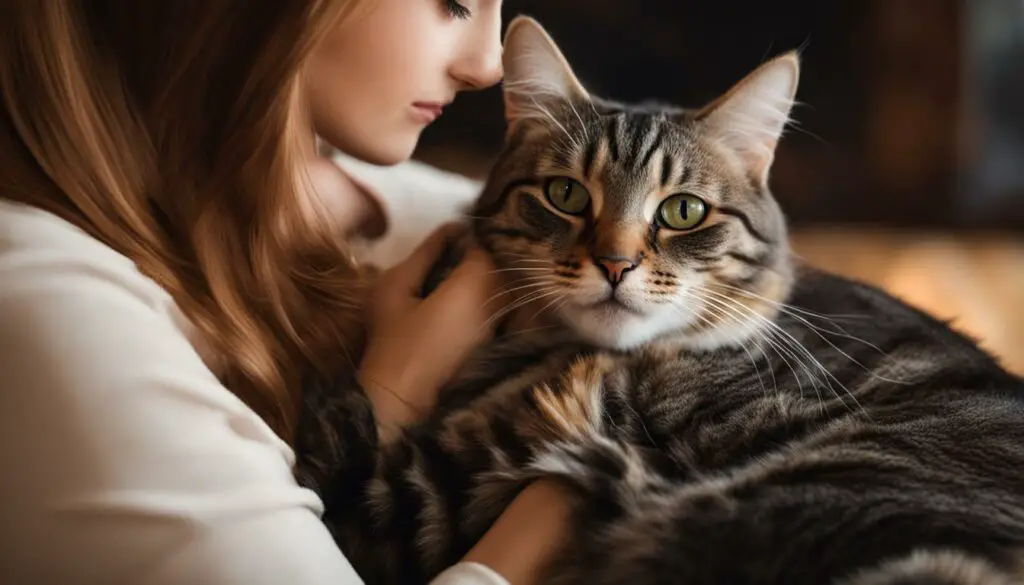
Conclusion
Understanding why cats head bump their human companions is crucial for decoding their behavior and establishing a strong bond. This feline behavior, also known as head bunting, serves as a form of communication through scent marking and signifies acceptance, trust, and love. By reciprocating this affectionate gesture, we can deepen the emotional connection between cats and humans.
Through head bumping, cats create a sense of unity and belonging, both within their colony and with their human family. The transfer of pheromones during head bunting reinforces the bond and strengthens the social interaction. By observing and interpreting cat behavior, we can decipher their love language and respond in a way that nurtures their emotional well-being.
Cat-human bonding is not limited to head bumping alone. Cats show affection in various unique ways, such as slow blinks, grooming, bringing gifts, and vocalizations. Recognizing and appreciating these gestures of love enhances the overall connection and enriches the relationship between cats and their human companions.
So, if your cat head bumps your hand, embrace the opportunity to reciprocate the affection. Engage in gentle headbutts, provide chin scratches, and give them the attention they seek. By understanding and embracing cat communication, we can foster a deep and meaningful bond that brings joy and fulfillment to both cats and their owners.
FAQ
Why does my cat head bump my hand?
Cats head bump as a sign of acceptance, love, and bonding. It is a way for them to communicate and mark their scent on you.
What does cat head bumping mean?
Cat head bumping is a form of communication through scent marking. It signifies affection, trust, and unity within a colony or family.
Why do cats head bump objects?
Cats head bump objects to mark them as part of their territory and create a familiar and safe environment for themselves.
How should I respond to cat head bumping?
You can reciprocate by gently headbutting the cat back, providing chin scratches or gentle pets, and paying attention to their purring.
What is the difference between head bunting and head pressing?
Head bunting is a gesture of affection and trust, while head pressing indicates discomfort or neurological issues and requires immediate veterinary attention.
What if my cat doesn’t headbutt me?
Not all cats engage in head bumping behavior. Cats have different ways of showing affection, such as slow blinks, grooming, bringing gifts, and greeting at the door.
How does cat head bumping involve scent sharing?
Cat head bumping involves rubbing their scent glands on you, leaving pheromones that strengthen the bond between cats and their human companions.
What role does cat head bunting play in social bonding?
Cat head bunting is a way for cats to spread the family scent, groom one another, and strengthen their bond within a social hierarchy.
What should I do if my cat hits their head?
Assess the severity of the impact and consult a vet if there are signs of severe injury, unconsciousness, or seizures. Mild bumps may only require rest and observation.
Why is cat affection and bonding important?
Cat affection and bonding contribute to a strong and healthy relationship between cats and their human companions, enhancing overall well-being.
How can I understand cat communication through head bunting?
By observing and interpreting cat behavior, including head bunting, you can gain insights into their emotions, feelings of attachment, and social interactions.
What are the unique ways cats show affection?
Cats show affection through slow blinks, grooming, bringing gifts, and vocalizations, in addition to head bumping. Each cat has its own unique love language.
Conclusion
Understanding cat head bumping and other forms of feline communication can deepen the bond between cats and their human companions, leading to a more fulfilling relationship.

